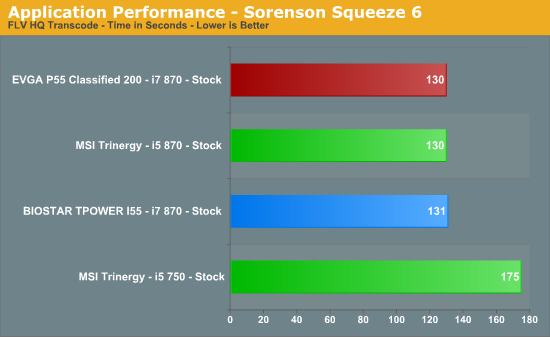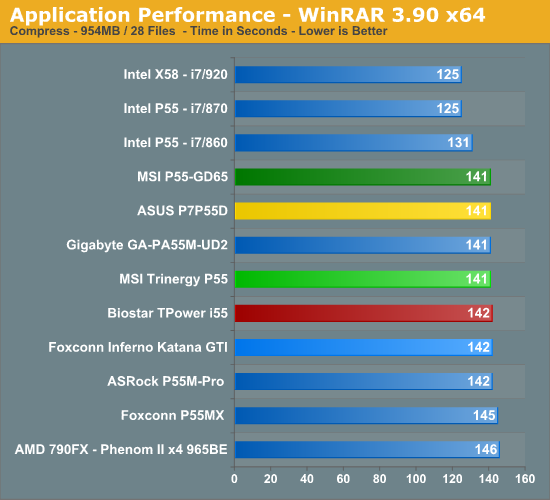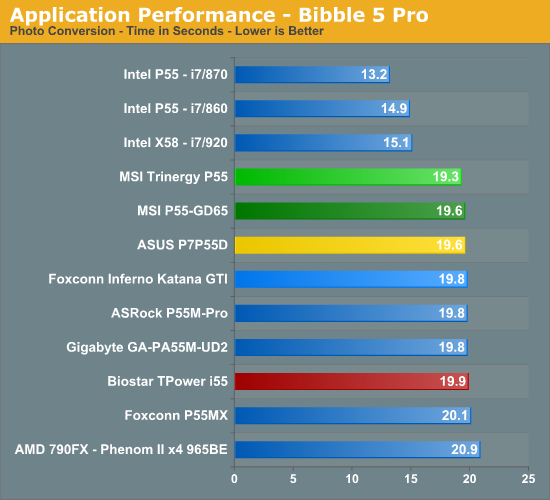System Benchmarks
Sorenson Squeeze 6
We are using Sorenson Squeeze to convert eight AVCHD videos into HD Flash videos for use on websites. This application heavily favors physical core count and processor clock speed.

WinRAR 3.9 x64
This benchmark compresses our AT workload consisting of a main folder that contains 954MB of files in 15 subfolders. The result is a file approximately 829MB in size.

Bibble 5.0
We utilize Bibble Labs' Bibble 5 v2 to convert 50 RAW image files into full size JPEG images with the program's default settings. This program is fully multithreaded and multi-core aware.











12 Comments
View All Comments
a4mula - Wednesday, January 20, 2010 - link
I'm sorry, but did I miss the part of this article where we were trying to come to a consensus on the performance of the NF200 for tri configurations on the limited 1156? Why go with a board that doesn't even come close to saturating the 8x bandwidth limit. Trifire 5870's, QuadfireX dual 5970's. We learned absolutely nothing other than the 1156's 16x pcie to die lanes still bottleneck in a 275 trisli. Where are the real reviews of NF200 + 1156?dia - Wednesday, January 27, 2010 - link
I think you've answered your own question. If 275's are bottlenecked somewhat; going by the fact they 'dont saturate 8x bandwidth', how do you think the higher performance cards will fare?You're probably looking at a 2~5% performance drop maximum on the current cards.
DeepThought86 - Wednesday, December 23, 2009 - link
How about adding stability to all your reviews. Run for 24 with the highest TDP proc that's officlally supported along with the highest TDP video cards that will fit, see if it burns up or not.Rajinder Gill - Thursday, December 24, 2009 - link
I usually run LinX for the stability testing stuff overclocked (along with plenty of application testing). Which is plenty IMHO.Holly - Saturday, December 26, 2009 - link
Well, to be honest, it is and it isn't... These days systems are way too complex to be able to draw really good stability conclusion...Just an example... My old E6300 (the 1.86GHz one) runs perfectly stable 24/7 on 2.975GHz (7x425) at 1.2V flat... and it runs without any troubles... games, C++ compilations, complex Maple calculations...
You'd say it runs perfect... well until I installed SSSE3 optimized Seti@Home application (instead of normal one that was running for like half year on this machine)... and guess what... CPU temperature went up by 5°C (water cooled) compared to previous top and computer went BSOD in couple of minutes. To compensate I had to either drop FSB to 410MHz or raise voltage to 1.224V.
Long story short... we can't hope to be able to really load the cpu 100%... yes, it doesn't idle when you stress it, but in fact how big part of the core is actualy working and how big part is taking a nap?
I would suggest trying mentioned optimized S@H on the system you consider stable (I am not saying it will crash, but the possibility is there)... We use the app at my friend's computer shop and usualy if there is a problem with hardware the machine goes BSOD in few minutes of testing... It's a bit drastic but very fast way to check failed OC.
Merry Xmas,
Holly
sgtpokey - Wednesday, December 23, 2009 - link
Dear Anandtech Staff,You don't have to invent your own nomenclature (OVERVIEW/CONCLUSIONN) for having an "Executive Summary" (or shorten it to "Summary" if you want) leading off the analytical article.
Calling anything other than the concluding section a "Conclusion" is a bit jarring.
Thank you for your time,
sgtpokey
Etern205 - Wednesday, December 23, 2009 - link
When AT first introduced this "overview/conclusion", I can't believe how many readers actually agree with this type of approach. Sure AT is a great site, but it does not mean you will need to agree on everything they do.I still prefer the old fart method
intro-->article w/pics-->benchies-->conclusion/author's pov
strikeback03 - Wednesday, December 23, 2009 - link
They probably have some page hit numbers they could pull out, but I wouldn't be at all surprised to find out that the majority of readers hit the conclusion (whether at beginning or end) before reading any graphs or descriptive text.As far as the board goes, meh, it seems to be a relatively competent, really expensive board mostly designed to stroke the companies' ego rather than provide something useful to 99% of potential users
Kenenniah - Wednesday, December 23, 2009 - link
Conclusion can easily mean the reviewer's conclusion and not the conclusion of the article itself.at80eighty - Wednesday, December 23, 2009 - link
I'm undecided about AT's new "draw your own conclusions' approach